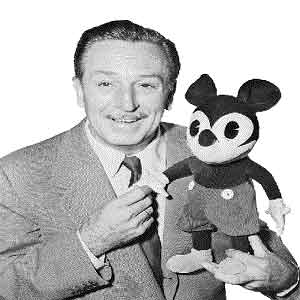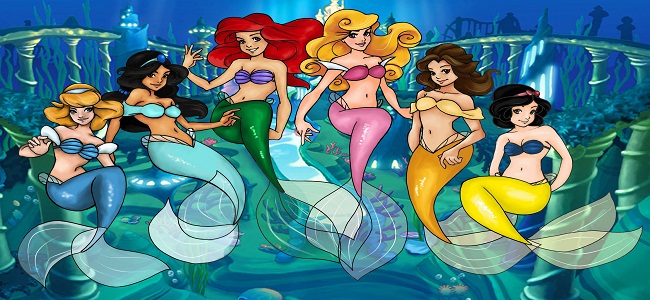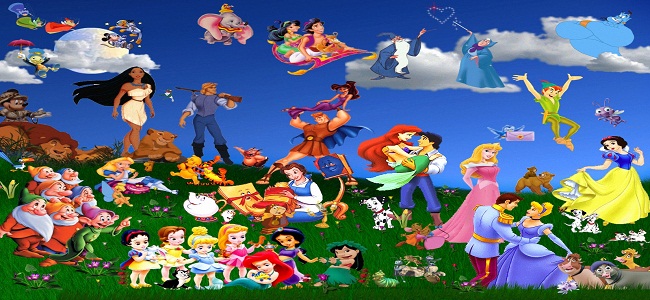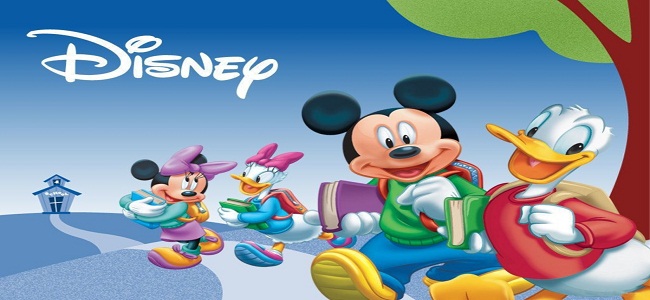Walt Disney
The man who created Mickey Mouse
Walter Elias "Walt" Disney (December 5, 1901 – December 15, 1966) was an American film producer, director, screenwriter, voice actor, animator, entrepreneur, entertainer, international icon, and philanthropist, well known for his influence in the field of entertainment during the 20th century. Along with his brother Roy O. Disney, he was co-founder of Walt Disney Productions, which later became one of the best-known motion picture producers in the world. The corporation is now known as The Walt Disney Company and had an annual revenue of approximately US$36 billion.
Disney is particularly noted as a film producer and a popular showman, as well as an innovator in animation and theme park design. He and his staff created some of the world's most well-known fictional characters including Mickey Mouse, for whom Disney himself provided the original voice. During his lifetime he received four honorary Academy Awards and won 22 Academy Awards from a total of 59 nominations, including a record four in one year, giving him more awards and nominations than any other individual in history. Disney also won seven Emmy Awards and gave his name to the Disneyland and Walt Disney World Resort theme parks in the U.S., as well as the international resorts Tokyo Disney Resort, Disneyland Paris, and Hong Kong Disneyland.
Early Days
Disney was born on December 5, 1901, at 2156 N. Tripp Avenue in Chicago's Hermosa community area to Irish-Canadian father Elias Disney and Flora Call Disney, who was of German and English descent. His great-grandfather, Arundel Elias Disney, had emigrated from Gowran, County Kilkenny, Ireland where he was born in 1801. Arundel Disney was a descendant of Robert d'Isigny, a Frenchman who had travelled to England with William the Conqueror in 1066. With the d'Isigny name anglicised as "Disney", the family settled in a village now known as Norton Disney, south of the city of Lincoln, in the county of Lincolnshire.
In 1917, Disney began his freshman year at McKinley High School and took night courses at the Chicago Art Institute. He became the cartoonist for the school newspaper, drawing patriotic topics and focusing on World War I. Despite dropping out of high school at the age of sixteen to join the army, Disney was rejected for being underage. After his rejection by the army, Walt and a friend decided to join the Red Cross. Soon after joining he was sent to France for a year, where he drove an ambulance, but only after the armistice was signed on November 11, 1918.
Immediately after World War I, Walt moved back to Kansas City to begin his artistic career. After considering whether to become an actor or a newspaper artist, he decided on a career as a newspaper artist, drawing political caricatures or comic strips. But when nobody wanted to hire him as either an artist or even as an ambulance driver, his brother Roy, then working in a local bank, got Walt a temporary job through a bank colleague at the Pesmen-Rubin Art Studio where he created advertisements for newspapers, magazines, and movie theaters. At Pesmen-Rubin he met cartoonist Ubbe Iwerks and when their time at the studio expired, they decided to start their own commercial company together.
The Start
In January 1920, Disney and Iwerks formed a short-lived company called, "Iwerks-Disney Commercial Artists". However, following a rough start, Disney left temporarily to earn money at the Kansas City Film Ad Company, and was soon joined by Iwerks who was not able to run their business alone. While working for the Kansas City Film Ad Company, where he made commercials based on cutout animations, Disney became interested in animation, and decided to become an animator. The owner of the Ad Company, A.V. Cauger, allowed him to borrow a camera from work to experiment with at home. After reading the Edwin G. Lutz book Animated Cartoons: How They Are Made, Their Origin and Development, Disney considered cel animation to be much more promising than the cutout animation he was doing for Cauger. Walt eventually decided to open his own animation business, and recruited a fellow co-worker at the Kansas City Film Ad Company, Fred Harman, as his first employee. Walt and Harman then secured a deal with local theater owner Frank L. Newman, arguably the most popular "showman" in the Kansas City area at the time, to screen their cartoons at his local theater, which they titled Laugh-O-Grams.
The Struggle
Presented as "Newman Laugh-O-Grams", Disney's cartoons became widely popular in the Kansas City area and through their success, he was able to acquire his own studio, also called Laugh-O-Gram, for which he hired a vast number of additional animators. Unfortunately, studio profits were insufficient to cover the high salaries paid to employees. Unable to successfully manage money, Disney's studio became loaded with debt and wound up bankrupt whereupon he decided to set up a studio in the movie industry's capital city, Hollywood, California.
Disney and his brother Roy pooled their money and set up a cartoon studio in Hollywood where they needed to find a distributor for Walt's new Alice Comedies, which he had started making while in Kansas City but never got to distribute. Disney sent an unfinished print to New York distributor Margaret Winkler, who promptly wrote back to him that she was keen on a distribution deal for more live-action/animated shorts based upon Alice's Wonderland.
The new series, Alice Comedies, proved reasonably successful. By the time the series ended in 1927, its focus was more on the animated characters and in particular a cat named Julius who resembled Felix the Cat, rather than the live-action Alice.
Disney went to New York in February 1928 to negotiate a higher fee per short and was shocked when Mintz told him that not only did he want to reduce the fee he paid Disney per short but also that he had most of his main animators, including Harman, Ising, Maxwell, and Freleng—but not Iwerks, who refused to leave Disney—under contract and would start his own studio if Disney did not accept the reduced production budgets. Universal, not Disney, owned the Oswald trademark, and could make the films without Walt. Disney declined Mintz's offer and as a result lost most of his animation staff whereupon he found himself on his own again.
It subsequently took his company 78 years to get back the rights to the Oswald character when in 2006 the Walt Disney Company reacquired the rights to Oswald the Lucky Rabbit from NBC Universal, through a trade for longtime ABC sports commentator Al Michaels.
Birth of Mickey Mouse
After losing the rights to Oswald, Disney felt the need to develop a new character to replace him, which was based on a mouse he had adopted as a pet while working in his Laugh-O-Gram studio in Kansas City. Ub Iwerks reworked the sketches made by Disney to make the character easier to animate although Mickey's voice and personality were provided by Disney himself until 1947. In the words of one Disney employee, "Ub designed Mickey's physical appearance, but Walt gave him his soul." Besides Oswald and Mickey, a similar mouse-character is seen in the Alice Comedies, which featured "Ike the Mouse". Moreover, the first Flip the Frog cartoon called Fiddlesticks showed a Mickey Mouse look-alike playing fiddle. The initial films were animated by Iwerks with his name prominently featured on the title cards. Originally named "Mortimer", the mouse was later re-christened "Mickey" by Lillian Disney who thought that the name Mortimer did not fit. Mortimer later became the name of Mickey's rival for Minnie – taller than his renowned adversary and speaking with a Brooklyn accent.
The first animated short to feature Mickey, Plane Crazy was a silent film like all of Disney's previous works. After failing to find a distributor for the short and its follow-up, The Gallopin' Gaucho, Disney created a Mickey cartoon with sound called Steamboat Willie. A businessman named Pat Powers provided Disney with both distribution and Cinephone, a sound-synchronization process. Steamboat Willie became an instant success, and Plane Crazy, The Galloping Gaucho, and all future Mickey cartoons were released with soundtracks. After the release of Steamboat Willie, Disney successfully used sound in all of his subsequent cartoons, and Cinephone also became the new distributor for Disney's early sound cartoons. Mickey soon eclipsed Felix the Cat as the world's most popular cartoon character and by 1930, despite their having sound, cartoons featuring Felix had faded from the screen after failing to gain attention. Mickey's popularity would subsequently skyrocket in the early 1930s.




